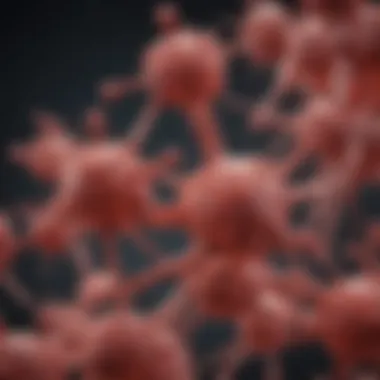AQP5 Antibody: Functions, Applications & Implications


Intro
Aquaporin 5 (AQP5) is a protein that has caught the attention of researchers in various fields of biology and medicine. It functions primarily as a water channel, facilitating the movement of water molecules across cell membranes. Understanding AQP5 and its antibodies plays a critical role in unraveling many physiological processes and pathologies. This article serves as a comprehensive guide focused on AQP5 antibodies, elaborating on their functions, applications, and implications across different domains.
Research Background
Overview of the scientific problem addressed
The primary challenge addressed in this study revolves around the interpretation of AQP5's role within the cellular environment. Disturbances in the function of AQP5 can lead to a myriad of diseases, particularly those involving fluid imbalance. For example, dysfunction in fluid transport is frequently observed in conditions such as dehydrated lungs, salivary glands disorders, and corneal edema. Antibodies specific to AQP5 become vital in both diagnosing and treating such conditions, as they can elucidate AQP5 function and its pathophysiological relevance.
Historical context and previous studies
Historically, the significance of water channels was first illustrated in the mid-1990s through pioneering research that revealed the presence of aquaporins in various human tissues. Early studies established AQP5 as a critical mediator of water transport, especially in epithelial tissues such as lungs and glands. Subsequent investigations highlighted the implications of altered AQP5 expression in diseases like cystic fibrosis and Sjögren's syndrome. These findings laid the groundwork for researching AQP5 antibodies, their biogenesis, and therapeutic potential. Recent developments have further expanded our understanding of AQP5 antibody functions, positioning them as crucial tools in both diagnostic and therapeutic methodologies.
Findings and Discussion
Key results of the research
The findings demonstrate that AQP5 antibodies not only serve as indicators of disease but also have a direct impact on our understanding of cellular mechanisms. Research indicates that these antibodies can influence AQP5 activity, ultimately affecting water permeability in various tissues. This presents a dual perspective wherein AQP5 antibodies can be tools for diagnosis and agents for potential intervention in specific diseases.
Interpretation of the findings
The implications of these findings are significant. By recognizing the multifaceted role of AQP5 antibodies, we can begin to appreciate their potential in therapeutic contexts. The precise mechanisms through which these antibodies exert effects on AQP5 functionality promise to unveil novel treatment strategies in fluid regulation within the body. Moreover, their application in diagnostics indicates a pathway for improved disease forecasting and management. By continuing to explore this territory, we anticipate advancements that will enrich current practices in medical science and clinical applications.
Foreword to AQP5 Antibody
AQP5 antibody represents a significant focal point in the analysis of cellular processes and disease mechanisms. Antibodies against Aquaporin 5 (AQP5) enable researchers to explore both physiological and pathological states of various tissues. Their relevance extends beyond mere identification; they play a critical role in understanding fluid transport, cell signaling, and even tumor progression.
Understanding the implications of AQP5 antibodies contributes notably to several fields including molecular biology, immunology, and clinical research. Investigating these antibodies leads to insights into potential applications in diagnostics and therapeutics, particularly concerning diseases affecting epithelial tissues. In this article, we will delve deeper into these aspects to provide a clear understanding of AQP5 antibodies and their value in contemporary research.
Understanding Aquaporins
Aquaporins are integral membrane proteins that facilitate water transport across cell membranes. These proteins are vital for maintaining water homeostasis in various biological systems. The AQP family includes several isoforms, with AQP5 being particularly significant in epithelial tissues such as the lungs and salivary glands. AQP5 plays important roles at the cellular level, influencing osmotic equilibrium and aiding in the secretion of bodily fluids.
In addition to water transport, aquaporins influence cellular signaling pathways. They help in regulating processes like apoptosis, cellular migration, and proliferation. The functional diversity of aquaporins suggests their involvement in multiple physiological processes, highlighting the importance of studying their corresponding antibodies.
Role of AQP5 in Physiology
The physiological implications of AQP5 are profound. Primarily, AQP5 functions as a water channel that promotes rapid water movement, crucial for hydration of epithelial surfaces. This is especially important in organs that require dynamic water balance such as the lungs, where AQP5 assists in maintaining the thin water layer necessary for gas exchange.
Equally, AQP5 plays a role in saliva production in salivary glands. This function is critical for proper digestion and oral health. Alterations in AQP5 expression can lead to dysfunction, which is observed in conditions like Sjögren's syndrome, where a key symptom is dry mouth due to insufficient saliva production.
In summary, AQP5 antibodies not only aid in studying the protein's functionality but also have far-reaching implications for understanding diseases linked to aquaporin dysregulation. This complexity underscores the necessity of researching AQP5 and its antibodies to better grasp their potential in clinical settings.
Biochemistry of AQP5 Antibodies
The biochemistry of AQP5 antibodies is a central topic in understanding their functionality and application in both diagnostic and therapeutic settings. AQP5, or Aquaporin 5, is critical in regulating water transport across cell membranes, particularly in epithelial tissues. This section explores the structure of AQP5 and the production of antibodies specific to it, examining their significance in research and clinical practices.
Structure of AQP5
AQP5 is a member of the aquaporin family of water channel proteins. It is composed of six transmembrane domains and contains a central pore that facilitates water transport. The protein's structure includes two cytoplasmic loops and a short N-terminus and C-terminus. Key residues within this structure are critical for determining the channel's permeability to water and ions. Notably, the alignment of the transmembrane helices forms a narrow channel where water molecules can pass through while excluding ions and other solutes. This specific architecture enables AQP5 to function efficiently in tissues like the lungs and salivary glands.


In terms of biochemical properties, AQP5 exhibits a selectivity that is vital for maintaining osmotic balance within cells. By regulating the flow of water, AQP5 plays a role in homeostasis and enhances responsiveness to physiological changes. The ability to generate antibodies against AQP5 provides tools for studying its molecular details and interactions.
Production of AQP5 Antibodies
The production of AQP5 antibodies typically involves the immunization of host organisms, often mice or rabbits, with synthesized peptides or recombinant proteins reflecting the AQP5 structure. The aim is to elicit a robust immune response, where B cells produce specific antibodies against AQP5 epitopes. Following immunization, these antibodies are purified through various techniques.
Considerations in antibody production include:
- Antigen specificity: Ensuring that antibodies specifically bind to the AQP5 protein without cross-reacting with other aquaporins.
- Purification techniques: Methods such as affinity chromatography are commonly used to isolate high-affinity antibodies for further applications.
- Quality control measures: Testing for specificity and sensitivity is essential to confirm the antibodies’ reliability in experimental settings.
The understanding of AQP5 antibody production provides fundamental insights into their application in diagnostics. For instance, detecting AQP5 expression in human tissues can aid in the study of various diseases, including lung disorders and cancers.
In summary, the biochemistry of AQP5 antibodies is foundational to exploring their roles in research. Knowledge of AQP5 structure informs antibody design, while effective production techniques enhance their utility in diagnosing and treating diseases.
Clinical Applications
The clinical applications of AQP5 antibodies hold significant potential in various fields of medicine. Understanding these applications is crucial as they can directly influence diagnosis and treatment strategies. AQP5 antibodies can be integral in both diagnostic and therapeutic contexts, providing insights into disease mechanisms and aiding in the management of pathologies.
Diagnostic Utilization
AQP5 antibodies can serve as a useful tool in diagnosing various diseases. Their specificity to Aquaporin 5 increases the accuracy of detection in conditions where altered expression of this water channel is relevant. Particularly in lung diseases, changes in the levels of AQP5 can indicate pathological states such as pulmonary edema or lung injury. The detection of these antibodies can also assist in identifying the severity of the disease and monitoring progression.
Detecting AQP5 antibodies can enhance diagnostic accuracy in pulmonary ailments.
The methodology often involves techniques such as enzyme-linked immunosorbent assay (ELISA) and immunohistochemistry. These methods enable the quantification and localization of AQP5 antibodies in tissue samples, providing valuable information that might correlate with clinical symptoms and outcomes. Furthermore, the use of these antibodies can extend beyond respiratory diseases. They can aid in early identification of some cancers where aberrant expression of AQP5 is noted, thus facilitating timely intervention.
Therapeutic Potential
The therapeutic potential of AQP5 antibodies is an evolving area of interest. Their role as biomarkers is significant, as they can help gauge responses to treatment and potentially guide therapy adjustments. For instance, in certain types of cancer, modulation of AQP5 expression may be linked to the effectiveness of chemotherapy agents. Understanding this relationship opens avenues for personalized medicine approaches that could improve patient outcomes.
In addition to their diagnostic roles, AQP5 antibodies themselves may have therapeutic applications. Research is exploring ways to leverage these antibodies to correct dysfunctional water transport in cells. Such interventions could lead to innovative treatments for diseases characterized by water balance disturbances. The continued investigation into how AQP5 antibodies can be utilized in therapy is promising and represents a significant frontier in biomedical research.
In summary, the clinical applications of AQP5 antibodies cover a broad spectrum, from enhancing diagnostic precision to providing new therapeutic strategies. The ongoing research in this area may yield important breakthroughs, enriching our understanding of disease processes and ultimately improving patient care.
AQP5 in Disease Pathogenesis
The study of AQP5 in disease pathogenesis sheds light on the role of this water channel protein in various medical conditions. AQP5 plays crucial roles in maintaining cellular hydration, facilitating water transport, and regulating osmotic balance. Understanding how AQP5 functions and contributes to disease can inform therapeutic interventions and diagnostic strategies.
AQP5 and Lung Disease
AQP5 has a significant impact on lung function. It is expressed primarily in the alveolar epithelial cells, crucial for gas exchange. Disruptions in AQP5 function can lead to pulmonary edema, a condition where fluid accumulates in the lungs, hindering breathing. Elevated levels of AQP5 have been observed in conditions such as acute respiratory distress syndrome (ARDS). Studies suggest that modulating AQP5 expression may improve fluid management in the lungs, offering therapeutic potential for conditions that lead to hypoxemia.
Some of the key points regarding AQP5's involvement in lung disease include:
- Regulation of alveolar fluid balance.
- Influence on inflammation and injury response.
- Role in pulmonary fibrosis development.
Research continues to explore the distinct pathways through which AQP5 could be targeted to modify disease outcomes in pulmonary disorders.
Role in Cancer Biology
AQP5 has emerged as a critical factor in cancer biology, influencing tumor progression and metastasis. Many cancers, such as lung, breast, and bladder cancer, demonstrate altered AQP5 expression levels. In these cancers, AQP5 may promote tumor cell proliferation, migration, and invasion by enhancing water absorption and affecting cell volume regulation.


Furthermore, AQP5's involvement in creating a favorable microenvironment for tumor growth highlights its dual role in both normal physiology and pathological conditions. Notable aspects include:
- The link between AQP5 and tumor progression.
- Potential use of AQP5 as a biomarker in cancer diagnostics.
- Implications for targeted therapies that address AQP5's signaling pathways.
Understanding AQP5's function in oncogenesis could significantly enhance current cancer treatment methodologies.
Implications in Autoimmune Disorders
AQP5 also plays a role in autoimmune disorders, notably in conditions like Sjögren’s syndrome, which is characterized by dry eyes and mouth due to immune system attacks on glands that produce moisture. Research indicates that AQP5 is targeted by autoantibodies in this syndrome, disrupting its normal function and leading to glandular malfunction.
Furthermore, the association of AQP5 with inflammation and immune response suggests that it may serve as a potential target for therapeutic intervention. Considerations regarding AQP5 in autoimmune disorders include:
- Its role in glandular secretion and hydration.
- The effects of autoantibodies on patient health.
- Potential strategies to regulate AQP5 in treatment modalities.
In summary, AQP5 is integral in various disease pathogenesis contexts. Its function in lung disease, cancer biology, and autoimmune disorders showcases its diverse roles and potential as a therapeutic target. Understanding the underlying mechanisms will enhance our ability to develop effective treatments and improve patient care.
Technological Advancements in AQP5 Research
The study of AQP5 antibodies has benefitted significantly from various technological advancements. These technologies shape how researchers approach AQP5-related studies. Improved methodologies enhance the understanding of AQP5's biological functions and its involvement in diseases. This advancement opens new avenues for applications in diagnostics and therapeutics. As the research landscape evolves, these technologies continue to provide critical insights into AQP5 antibody utility.
Enzyme-Linked Immunosorbent Assay (ELISA)
The Enzyme-Linked Immunosorbent Assay, commonly known as ELISA, is a vital tool in AQP5 research. This technique allows for the quantitative detection of AQP5 antibodies in biological samples. The strength of ELISA lies in its sensitivity and specificity, making it an effective choice for various studies. Researchers use ELISA to assess autoimmune responses related to AQP5. It also plays an essential role in diagnostic applications, enabling the detection of specific antibody profiles in patients.
ELISA has several advantages, such as:
- High throughput capabilities, allowing for the analysis of multiple samples simultaneously.
- A user-friendly design, making it accessible for routine laboratory use.
- Cost-effectiveness compared to other techniques.
Western Blotting Techniques
Western blotting is another prominent method for the analysis of AQP5 antibodies. This technique provides qualitative and quantitative information regarding protein expression. In the context of AQP5, western blotting enables researchers to validate the presence of antibodies specific to AQP5 molecules.
The process involves separating proteins by gel electrophoresis, followed by transfer to a membrane for probing with antibodies. The clear distinction of bands allows for the determination of AQP5's expression levels in different cellular contexts. This technique is crucial for understanding variations in AQP5 levels across various conditions, particularly in disease states.
Immunohistochemistry Applications
Immunohistochemistry (IHC) is a powerful technique for localizing AQP5 proteins in tissue samples. It involves the use of specific antibodies to visualize AQP5 in fixed tissue sections. IHC gives context to AQP5's roles in physiology and pathology, highlighting its distribution and expression patterns.
The applications of IHC in AQP5 research include:
- Detecting abnormal AQP5 expression in cancerous tissues, providing insights into tumor biology.
- Assessing the implication of AQP5 in lung diseases by observing its localization in lung tissues.
- Investigating autoimmune disorders by examining tissue staining patterns.
The integration of technologies like ELISA, western blotting, and immunohistochemistry is essential for advancing AQP5 research, pushing the boundaries of what can be understood about its function and role in human health.
Challenges in AQP5 Antibody Research
The study of AQP5 antibodies presents multiple challenges that can impede progress in this field. Addressing these challenges is crucial for advancing our understanding of AQP5 and its role in various biological processes. The importance of recognising these obstacles lies in refining research methodologies and enhancing the effectiveness of diagnostic and therapeutic applications.
Specificity and Cross-Reactivity Issues
Specificity is a primary concern in AQP5 antibody research. The challenge arises when antibodies that are designed to target AQP5 also interact with other aquaporins or unrelated proteins. This cross-reactivity can lead to erroneous conclusions in experimental results. Evaluating the binding affinities of AQP5 antibodies to other proteins is essential. Researchers often undergo extensive validation processes to ensure that the antibodies they use do not bind indiscriminately. By utilising competitive inhibition assays or confirming the presence of distinct epitopes specific to AQP5, scientists can assess the specificity of their antibodies.


Moreover, techniques such as mass spectrometry can provide insight into potential off-target interactions. Only by ensuring high specificity in antibody interactions can one draw accurate correlations between AQP5 and any disease state.
Regulatory Challenges
Regulatory issues form another significant layer of complexity in AQP5 antibody research. The FDA and other regulatory agencies impose strict guidelines for antibody development, especially for those targeting therapeutic applications. Compliance with these regulations can be daunting, requiring researchers to maintain rigorous standards in sample preparation and experimental protocols.
Obtaining approval for clinical use of AQP5 antibodies entails navigating a multi-layered process. This includes demonstrating safety, efficacy, and consistency in antibody performance. Emerging technologies, like monoclonal antibodies, face even stricter scrutiny because of their intended use in human subjects. Furthermore, there is the increasing concern regarding reproducibility in scientific research. This has prompted regulatory bodies to demand comprehensive data supporting claims made by studies involving AQP5 antibodies.
The interplay of specificity and regulatory compliance is vital in ensuring the successful application of AQP5 antibodies in both diagnostics and therapeutics.
In summary, the challenges faced in AQP5 antibody research are significant. Understanding and overcoming issues related to specificity and regulatory constraints will not only enhance the validity of research outcomes but also pave the way for new clinical applications in the future.
Future Directions in AQP5 Antibody Research
The future directions in AQP5 antibody research hold significant promise for enhancing our understanding of both basic and clinical aspects of physiology. As research progresses, there will be a focus on refining diagnostic techniques and therapeutic methods while also integrating innovative technologies. The implications of such advancements can lead to improved patient outcomes, particularly in diseases linked to AQP5. Exploring these dimensions not only enhances scientific knowledge but also addresses practical health needs.
Expanding Diagnostic Applications
One of the most critical future directions involves expanding the diagnostic applications of AQP5 antibodies. Current uses may focus primarily on lung diseases and certain cancers. However, with the evolution of technology, the potential to apply AQP5 antibodies in other diagnostic fields becomes more feasible. For instance, autoimmune disorders may show correlation with altered AQP5 expression.
"The ability to detect AQP5 antibodies could lead to earlier diagnosis and more personalized treatment plans."
Thus, utilizing AQP5 antibodies in various diagnostic tests can enhance the specificity and sensitivity of detecting multiple pathologies. Ongoing research into the mechanisms of AQP5 will facilitate the identification of novel biomarkers, contributing significantly to the realm of personalized medicine. This can also aid in monitoring disease progression and response to therapy, reinforcing the antibody's role as a valuable tool in clinical diagnostics.
Innovations in Therapeutic Strategies
Another promising area is the innovation in therapeutic strategies involving AQP5 antibodies. There is potential for developing targeted antibody therapies that could selectively modulate the functions of AQP5 in disease states. Current therapies often involve generic approaches that do not specifically target the underlying mechanisms.
Innovative strategies may include the creation of monoclonal antibodies to either inhibit or enhance AQP5 activity. This could open pathways for treating chronic diseases characterized by dysregulation of water transport. For instance, in conditions like pulmonary edema, therapies targeting AQP5 could significantly improve fluid regulation, offering more effective management options. Moreover, combining these therapies with other treatment modalities may yield synergistic effects, enhancing overall efficacy.
Integration with Genomic Studies
The integration of AQP5 antibody research with genomic studies represents a forward-thinking approach. Genomics provides insights into the genetic underpinnings of diseases, which, when combined with antibody research, can enhance our understanding of AQP5's role. By analyzing how genetic variations affect AQP5 expression, researchers can identify populations at risk for specific health issues.
Furthermore, advancements in genomic technologies, such as CRISPR, could allow for alterations in AQP5 expression in model organisms. This can lead to deeper investigations into its involvement in cellular processes, thus delineating its multifaceted role in health and disease. The interconnection of these fields reinforces the importance of AQP5 antibodies as a central focus in future research, leading to groundbreaking discoveries in biology.
In summary, the directions outlined above signify not just a path forward but a necessity in leveraging AQP5 antibody research to address both existing and emerging challenges in health care. With continued investigation and innovation, the applications and implications of AQP5 antibodies are set to shape the future landscape of medical research.
End
The conclusion plays a vital role in synthesizing the key elements discussed throughout this article. It encapsulates the findings related to AQP5 antibodies, their diverse functions, applications, and future implications in the field of research and clinical practice. Summarizing these components helps one grasp not only the current understanding but also the areas needing further exploration.
Summary of Key Findings
The exploration of AQP5 antibodies has unveiled several essential insights:
- Role in Cellular Processes: AQP5 is a critical water channel involved in maintaining cellular hydration and homeostasis. Its involvement in various physiological processes highlights its significance.
- Clinical Relevance: AQP5 antibodies have shown potential in diagnosing and treating specific diseases, including lung diseases and certain types of cancers. Understanding these applications enhances their value in clinical settings.
- Research Implications: The ongoing research highlights challenges such as specificity issues and the need for innovative techniques. Addressing these challenges could lead to improved diagnostics and therapies in the future.
The culmination of these points underscores the multifaceted roles of AQP5 antibodies, reinforcing their importance in both basic research and clinical applications.
Implications for Future Research
Future research directions regarding AQP5 antibodies appear promising, not only in expanding their diagnostic applications but also in refining therapeutic strategies. Key implications include:
- Expanding Diagnostic Applications: There is a significant need for further exploration into the biomarker potential of AQP5 antibodies in various diseases.
- Innovations in Therapeutic Strategies: Developing therapies that target AQP5 could lead to breakthrough treatments for conditions related to aberrant water transport.
- Integration with Genomic Studies: By combining AQP5 research with genomic studies, new insights into how genetic variations affect AQP5 functionality could emerge, leading to more targeted interventions.
The future requires a collaborative approach across disciplines, combining immunology, genomics, and clinical research to fully realize the potential of AQP5 antibodies. As this research evolves, so too will the understanding of various diseases and their pathophysiology.







